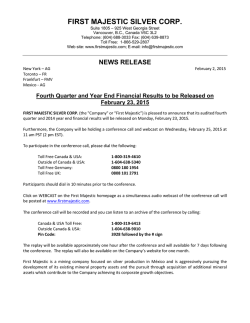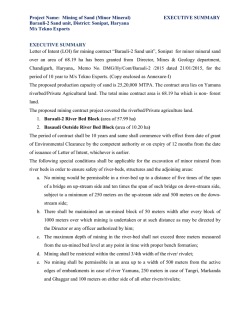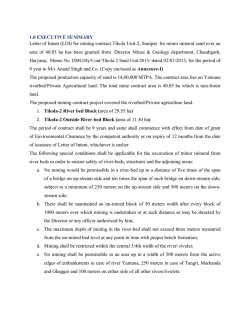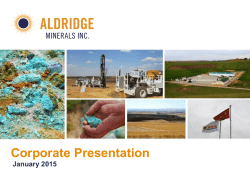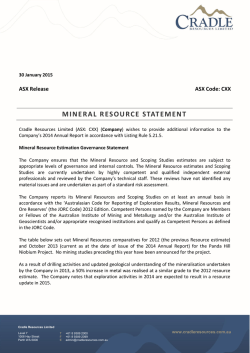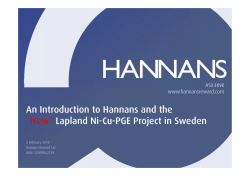
Tenke Fungurume Summary Report
January 2015 Reserves & Resources as at Dec 31, 2013 Tenke Fungurume Mine DRC Tenke Fungurume Project Description and Location TFM’s copper-cobalt deposits comprise one of the world’s largest known copper-cobalt resources. The deposits are located on contiguous concessions which total in excess of 1,500 km2. These concessions are located in Katanga Province, DRC, approximately 175 km northwest of Lubumbashi, the provincial capital. Key Facts Construction started in late 2006 on open-pit and oxide ore processing facilities designed to produce 115,000 tpa of cathode copper and over 8,000 tpa of cobalt in hydroxide. Commissioning of the copper facilities occurred at the end of the first quarter 2009, and of the cobalt hydroxide facilities at the end of the second quarter. By year end 2009, full name plate capacities for both products were being achieved. Subsequent debottlenecking and plant upgrades allowed expansion to increase to 132,000 tpa of copper cathode and approximately 11,000 tpa cobalt hydroxide. A further Phase 2 Expansion of the plant was substantially completed at the end of 2013, which has increased nameplate capacity to 195,000 tpa of copper cathode and 15,000 tpa cobalt hydroxide. • Open pit mine • Copper and cobalt • 2015 estimate ~50,000 tonnes copper cathode (24%) • Cash costs pending • Ownership 24% equity interest The first phase of production is one of several stages of development contemplated with the objective of ultimately producing in excess of 500,000 tpa of copper mining multiple deposits concession-wide. Contents Description 1 Accessibility, Climate 1 At-a-Glance 2 History 3 Geological Setting 4 Exploration 5 Mineralization 5 Drilling 5 Mining 6 Environmental and Social Aspects 6 Reserves/Resources 7 Sampling 8 Security of Samples 8 Notes 8 Accessibility, Climate, Local Resource, Infrastructure and Physiography The main highway, railroad and power line connecting Kolwezi and Likasi with Lubumbashi pass through the concessions. Scheduled air services are available between Lubumbashi and the capital at Kinshasa, as well as from Johannesburg, South Africa and Zambia. An airstrip constructed on the concession can accommodate freight aircraft and small passenger jets. Most copper and cobalt product and bulk mine consumables are shipped primarily by truck and to an extent by rail between Tenke and ports in Durban, South Africa and Dar-es-Salaam, Tanzania. The site climate is characterized as mild, rainy, sub-tropical mid-latitude with dry winters, with three seasons. The average annual rainfall is approximately 1,150 mm. Monthly average temperatures are 28°C (max); 20°C (min) in September and 22°C (max); 13°C (min) in June. Tailings facilities are located to the north of the process plant site and a first raise of the initial facility was completed during 2010. The current tailings storage location is of sufficient size to handle the majority of currently proven/probable reserves. Other adjacent areas have been identified to provide life-of-mine storage capacity. A potential location for a future sulphide concentrator has been identified as have potential heap leach pad areas. Electrical power is provided from the national grid. The local Nseke hydro power station is being renovated and expanded as part of the project and new local power lines have been constructed. Water from local boreholes supplements runoff water collected and the project is operated in line with a zero discharge water management philosophy. The dominant landform is the Dipeta Syncline, an east-west trending valley approximately 15 km long and 3 km wide. The Dipeta River runs along the valley bottom while the Kwatebala, Tenke (formerly 1 called Goma) and Fwaulu orebodies lie on the north-western crest of this valley. The orebodies presently form hills and ridges rising to elevations of about 1,500 m above sea level and up to 170 m above adjacent valleys. The plant site elevation is 1,200 m above sea level. The ore deposits lie on a surface water divide, with waters to the north flowing into the Mofya River and waters to the south flowing into the Dipeta River. The flora of the concessions is dominated by an agricultural mosaic of croplands and fallow fields. The second most common vegetation type is miombo woodland. The third most common type of vegetation is degraded miombo woodland (miombo woodland that has been impacted by agricultural clearing activity). Copper-cobalt vegetation types occupy less than five percent of the area. Tenke Fungurume at-a-Glance Tenke Fungurume Mine (24% equity interest) Location Katanga Province, Democratic Republic of Congo Ownership Lundin Mining 24%, FCX 56%, Gécamines 20% Type of ore body Sedimentary copper and cobalt Primary metal Copper Secondary metal Cobalt 2P Reserves 144 mt @ 2.9% Cu, 0.4% Co (100% basis) Type of mine Open pit Mine facilities and method Vermeer surface miner, drill and blast, loader and truck Processing facilities Milling and leaching circuit; solvent extraction feeding a copper tankhouse (115 ktpa cathode capacity) and a cobalt plant (8 ktpa hydroxide capacity); SO2 plant; sulphuric acid plant; tailings impoundment End product Copper cathode, cobalt hydroxide Expected mine life 40+ years Employees 3,000 full-time employee equivalents Potential growth Tenke is a mining district with over 20 identified deposits containing oxide, sulphide and mixed ores to depths of up to 2,000 metres 2015 Targets Production Copper Cash costs USc/lb ~50,000 tonnes attributable share in 2015 Pending 2 History and Development Terms The Tenke Fungurume deposits have a history dating back to at least 1917. A controlling interest in the concessions was acquired from Gécamines following a lengthy tender process, and in November 1996, pursuant to a mining convention and TFM formation agreement, the concessions were transferred to TFM in exchange for a series of transfer bonus payments and other significant commercial and development commitments. TFM was established in December 1996 under the DRC Companies Act and formed for the purpose of developing the deposits of copper, cobalt and associated minerals under mining concession nº 1981 and mining concession nº 1992 granted to TFM in 1996 at Tenke and Fungurume. TF Holdings paid Gécamines the first stage of the transfer payments ($50 million) in May 1997. In December 1998, Tenke Mining concluded an option agreement with BHP Copper Inc. (now BHP Billiton (“BHPB”)) which established a formal structure for BHPB to acquire, directly or indirectly, a controlling interest in the Tenke Fungurume project. In December 2000, Phelps Dodge entered into an agreement with BHPB, whereby Phelps Dodge had the opportunity to earn up to one-half of BHPB’s position. On September 13, 2002, BHPB’s rights and obligations under the option agreement with the Corporation were formally transferred to Phelps Dodge. As a result of the DRC’s new 2002 World Bank sponsored mining code and other developments resulting from the DRC conflict, an extensive renegotiation process commenced upon formation of the transitional government in 2003, which successfully concluded with amended agreements (“Amended Agreements”) in late 2005. Pursuant to the terms agreed in the Amended Agreements, including the ARMC, the single purpose joint venture company, TF Holdings then controlled 70:30% by FCM and Tenke Mining, agreed to pay Gécamines an additional US$50 million in stages based on pre-agreed development-related milestones. In accordance with shareholding agreements finalized between FCM and Tenke Mining in January 2004, FCM was obligated to fund $42.5 million of this balance, with Tenke Mining funding the remaining $7.5 million. Upon the entry into force of the Amended Agreements, TF Holdings paid Gécamines $15 million. Additional payments of $5 million on a positive build decision; $10 million on commencement of commercial operations, and $10 million on each of the two successive anniversaries of commencement of commercial operations were made, which payments have now been paid in full. As the deposits have been brought to the ‘exploitation stage’, TFM enjoys all rights and privileges with respect to mining activity including surface usage. A positive build decision was made in December 2006 by then operator FMC. Initial facilities were ultimately designed for a capacity of 115,000 tpa copper production. The Amended Agreements contain objectives without guarantee of reaching in excess of 130,000 tpa copper production by year 5 and 400,000 tpa by year 11 of operations, subject to a number of qualifications including DRC conditions and markets. In early 2007, Freeport acquired FMC, which resulted in them taking over as operator and owner of a 70% interest in TF Holdings. In mid-2007, Lundin Mining acquired Tenke Mining, resulting in Lundin Mining controlling the remaining 30% of TF Holdings. This resulted in FCX indirectly holding 57.75% of TFM, and Lundin Mining indirectly holding 24.75% of TFM. Gécamines held the balance of ownership – 17.5% by way of a directly held carried interest in TFM. In accordance with the Amended Agreements, a base metals royalty is payable at the rate of 2% of net sales. In addition, a 1% net sales metals export duty applies. Full repatriation of funds is allowed, subject to a 10% expatriated dividends withholding tax. Income tax is payable at the rate of 30% and certain other minor taxes and duties apply as defined in TFM’s Amended Agreements consistent with the 2002 DRC Mining Code Title IX. In addition to the 15% of the base metals royalty that is defined to be repatriated by the GDRC to the region of the mine, TFM has committed to a 0.3% net sales social fund, to be administered annually to benefit local communities. Renumbered n° 123 by the Cadastre Minier Certificat d’Exploitation no CAMI/CE/940/2004 dated November 3, 2004; subsequently divided and renumbered no 123, no 9707 and no 9708 by the Ministère des Mines through Ministerial Decree dated February 20, 2009. 1 Renumbered no 159 by the Cadastre Minier Certificat d’Exploitation no CAMI/CE/941/2004 dated November 3, 2004; subsequently divided and renumbered no 159, no 4728 and no 4729 by the Ministère des Mines through Ministerial Decree dated July 7, 2006. 2 3 In February 2008, the Ministry of Mines, Government of the DRC, sent a letter seeking comment on proposed material modifications to the mining contracts for the Tenke Fungurume concession, including the amount of transfer payments payable to the government, the government’s percentage ownership and involvement in the management of the mine, regularization of certain matters under Congolese law and the implementation of social plans. In October 2010, the government of the DRC announced the conclusion of the review of TFM’s mining contracts. The conclusion of the review process confirmed that TFM’s existing mining contracts are in good standing and acknowledged the rights and benefits granted under those contracts. TFM’s key fiscal terms, including a 30% income tax rate, a 2% mining royalty rate and a 1% export fee, will continue to apply and are consistent with the rates in the DRC’s current Mining Code. In connection with the review, TFM made several commitments, which have been reflected in amendments to its mining contracts, including: an increase in the ownership interest of Gécamines, which is wholly owned by the government of the DRC, from 17.5% (non-dilutable) to 20.0% (non-dilutable), resulting in a decrease of Freeport’s effective ownership interest from 57.75% to 56% and Lundin Mining’s effective ownership interest from 24.75% to 24%; an additional royalty of $1.2 million for each 100,000 tonnes of proven and probable copper reserves above 2.5 million tonnes at the time new reserves are established by FCX; additional payments totalling $30 million to be paid in six equal installments of $5 million upon reaching certain production milestones; conversion of $50 million in intercompany loans to equity; a payment of approximately $5 million for surface area fees and ongoing surface area fees of approximately $0.8 million annually; incorporating clarifying language stating that TFM’s rights and obligations are governed by the ARMC; and expanding Gécamines’ participation in TFM management. TFM has also reiterated its commitment to the use of local services and Congolese employment. In connection with the modifications, the annual interest rate on advances from TFM shareholders increased from a rate of LIBOR plus 2% to LIBOR plus 6%. In December 2010, the addenda to TFM’s ARMC and Amended and Restated Shareholders’ Agreement were signed by all parties. In April 2011, the amended agreements were ratified by a Presidential Decree. On March 26, 2012, the President and Prime Minister of the DRC signed a decree approving the bylaw changes for TFM. Accordingly, the change in Lundin Mining’s ownership interest in TFM and the conversion of intercompany loans to equity became effective at that date. Geological Setting The Tenke Fungurume copper-cobalt deposits are typical of those that comprise the Central African Copperbelt. The Copperbelt is located in a major geological structure called the Lufilian Arc, a 500 km fold belt that stretches from Kolwezi in the southern DRC to Luanshya in Zambia. The deposits of the Tenke Fungurume district are located at the northernmost apex of the arc. The arc formed between the Angolan Plate to the southeast and Congo Plate to the northwest during the late Neoproterozic, approximately 650 to 600 million years before present (Ma). Rocks in the arc are exposed in a series of tightly folded and thrust anticlines and synclines, generally trending eastwest to southeastnorthwest in the southern DRC. The Tenke Fungurume group of sediment hosted copper cobalt deposits occurs near the base of a thick succession of sedimentary rocks belonging to the Katanga System of Proterozoic age (1050-650 Ma). The older rocks of the basement complex belonging to the Kibara Supergroup, form the framework within which the Katangan sediments were deposited and consist of granitic rocks and metamorphosed sediments. Sedimentation took place in shallow intra-cratonic basins bounded by rifts. A series of cratonic events of Pan African age (650 Ma to 500 Ma) resulted in extensive deformation of these rocks. The principal tectonic event is referred to as the Lifilian Orogeny and this led to the formation of the Lufilian Arc. All of the major Zambian and Congolese copper-cobalt deposits are located along this 500 km long arcuate structure, which extends from Kolwezi in the Congo to Luanshya in Zambia. The Tenke and Fungurume deposits are located in the northernmost apex of the arc. 4 Exploration and Concession Potential The mineral concessions have been subject to multiple phases of exploration over time. Exploration in 2013 continued the focus on finding additional high-grade oxide resources and the investigation of deeper mixed and sulphide mineralization. A total of 108,762 m of diamond drilling was completed during 2013 in 597 individual holes. The exploration objectives were to convert oxide and mixed resources to reserve class, locate additional oxide resources, add to existing resources of sulphide and mixed material and supply samples for mixed ore metallurgical sampling. A concession-wide airborne geophysical survey was carried out in June and July of 2013 by Fugro Airborne Surveys Ltd. A total of 5,545 line kilometres were flown over an area of approximately 1,000 km². The aircraft carried a time-domain electromagnetic CGG:TEMPEST system and also gathered radiometric data. TEMPEST was designed to acquire high resolution, fully calibrated TEM data that can be used in a quantitative fashion for both conductivity mapping applications and conductive target detection. Results will be used to define new exploration targets in the Mines Series units characterized by low conductivity near surface and higher conductivity at depth due to the presence of sulphide minerals. Underground development for bulk metallurgical sampling was started at Fungurume in 2012. A vertical shaft started in June 2012 and reached its final depth in late 2013. A crosscut has been started to intersect the mineralized units. The goal is to obtain mixed oxide-sulphide bulk samples for metallurgical testing in 2014. A similar shaft is also underway at Kwatebala again with bulk samples due in 2014. Due to data and time availability, there are still a number of deposits that have yet to be assessed with Mineral Resource and Reserve models. Mineralization The copper-cobalt mineralization is mainly associated with two dolomitic shale horizons (RSF and SDB respectively), each ranging in thickness from 5 to 15 m, separated by 20 m of cellular silicified dolomite (RSC). The main economic minerals present are malachite, chrysocolla, bornite, and hetrogenite. Primary copper and cobalt mineralogy is predominately chalcocite, digenite, bornite, and carrollite. Oxidation has resulted in widespread alteration producing malachite, pseudomalachite, chrysocolla (hydrated copper silicate) and heterogenite. The primary copper-cobalt mineral associations are homogeneous in both mineralized zones and any variations are due to the effect of oxidation and supergene enrichment. Consequently the mineral assemblages can be grouped into three main categories dependent upon the degree of alteration – oxide, mixed and sulphide zones. Dolomite and quartz are the main gangue minerals present. Dolomite or dolomitic rocks make up the bulk of the host strata. Weathering of the host rocks is normally depthrelated, intensity decreasing with increasing depth, producing hydrated iron oxides and silica at the expense of dolomite, which is leached and removed. 5 Mining Operations The Tenke Fungurume operation mines copper-cobalt oxide ores by open-pit mining techniques. Continuous miners are used to break the ore, and drill and blast is employed in the waste rock. Conventional loaders and trucks transport the ore to the crusher or stockpiles and the waste to dumps. Larger mining equipment is currently being introduced to enable increased mining rates. In 2013, production was sourced primarily from the Kwatebala, Fwaulu, Tenke and Mwandinlomba orebodies. The other orebodies are scheduled to be mined in a number of phases over time. The latest proven process technology is being used to extract copper and cobalt. Copper is extracted using standard SAG milling, sulphuric acid leach, solvent extraction and electro-winning (“SXEW”) to produce copper cathode. Solution from the copper SXEW plant feeds the cobalt plant where cobalt hydroxide is produced through purification and precipitation processes. Copper is marketed with guidance from FCX’s global copper marketing program. Cobalt is sold as cobalt hydroxide under contract and on the spot market. Nominal daily mill feed of oxide ore has increased from the original design of 8,000 tpd to 11,000 tpd to 14,500 tpd following several phases of plant debottlenecking and the completion of a Phase 2 expansion. Planned copper production levels have increased from 115,000 tpa to 132,000 tpa to 208,000 tpa. Capital investment of approximately $2.0 billion was made for the initial project facilities, which included aspects to support major future expansions. This included a projected $250 million for loans and overseeing of the provincial hydro power rehabilitation project to provide reliable power to the mine and national grid. Total power available to the TFM mine resulting from the power loan investment under agreement with SNEL (DRC power authority) is in excess of 200 MW to support expansions, which is more than sufficient for current plans. The Phase 2 expansion of Tenke Fungurume was substantially complete at 2013 year end increasing annual copper production by 50% to a nameplate of 195,000 tonnes copper cathode and 15,000 tonnes cobalt hydroxide. The expansion, which was substantially completed under budget at a cost of $670 million, included additional mining equipment, mill upgrades, acid plant expansion and a doubling of the existing tank house capacity. During 2011 and 2012, test scale on/off heap leach pads were constructed and operated on site to evaluate the potential of commencing heap leaching of the low grade ores that are currently being mined and stockpiled, and future utilization of the excess SX-EW capacity. FCX continues to engage in drilling activities, exploration analyses and metallurgical testing on mixed and sulphide ores to evaluate the full potential of the highly prospective minerals district at Tenke. These analyses are being incorporated in the evaluation of several further phases of expansion. Kokkola Kokkola, located in the Baltic Sea in Kokkola, Finland processes unrefined cobalt and related metals and manufactures advanced inorganic products for use in a variety of applications in fast-growing end use markets. Kokkola is the world‟s largest supplier of cobalt chemicals and powders for use in batteries, chemicals and ceramics and powder metallurgy. Kokkola has been in operation since 1968 and has an experienced management team, over 400 employees and global sales and marketing footprint that services approximately 500 customers in over 50 countries in Asia, Europe and the Americas. 6 Environmental and Social Aspects The Tenke project has been developed in accordance with Equator Principles, Voluntary Principles of Security and Human Rights, applicable World Bank/IFC standards and the Extractive Industries Transparency Initiative. Development and operation are subject to a number of DRC laws, regulations and standards dealing with the protection of public health, public safety and the environment. Permits and authorizations are in place for construction and operation. Key environmental issues addressed by the project include mitigation of damage to sensitive indigenous flora unique to highly mineralized areas of the DRC copper belt, design of the project to zero discharge objectives, and adoption of fully plasticlined process water and tailings storage impoundments. As this is the first commercial development of mining on the concessions, there are no known existing environmental liabilities. Key social investments addressed during project development include extensive community consultation and stimulation of both direct and indirect employment – during the initial phase of construction, employment peaked at more than 8,000 DRC nationals. As of December 2013, TFM employed approximately 3,400 full time personnel and 3,800 contractors. According to an economic impact assessment commissioned by TFM, both directly and indirectly TFM accounts for 5 percent of all formal employment in the DRC’s private sector. Other social investments include medical, fresh water supply, education, agricultural and regional infrastructure investments in power, roads and border crossings. 7 Combined Mineral Reserves and Resources – June 30, 2014 Tenke Fungurume and Candelaria December 31, 2013 Mineral Reserves Category 000’s Tonnes Cu % 266,725 92,025 Zn % Pb % Ni % Co % Contained Metal 000’s (Ounces millions) Zn Pb Au Ag Ni Co T T Oz Oz T T Au g/t Ag g/t Cu T Lundin Interest 0.6 0.1 2.1 1,533 1.14 18 80% 0.4 0.1 1.5 336 0.26 4 80% Copper Candelaria Proven Open Pit Proven (Stockpile) Probable 9,182 0.5 0.1 2.0 50 0.04 1 80% 367,932 0.5 0.1 1.9 1,919 1.45 23 80% Proven 7,897 1.1 0.2 4.6 85 0.06 1 80% Probable 4,591 1.0 0.2 4.4 46 0.03 1 80% 12,487 1.1 0.2 4.5 0.10 2 80% 4,907 4.2 0.9 0.2 39 206 45 11 6 100% Probable 20,748 2.4 0.7 0.2 36 501 139 39 24 100% Total 25,385 2.8 0.7 0.2 37 707 183 50 30 100% 3,328 2.2 0.3 35 73 10 4 100% 65 2.1 0.6 35 1 - - 100% 3,393 2.2 0.3 35 75 10 4 Total Underground Total Neves-Corvo Zinkgruvan Proven Proven Probable Total 132 100% Tenke Proven 52,116 3.7 0.4 1,907 203 24% Fungurume Proven (Stockpiles) 30,696 1.2 0.4 384 101 24% Probable 61,323 3.1 0.3 1,883 202 24% 144,135 2.9 0.4 4,174 506 24% Proven Probable 10,371 10,232 0.4 0.4 8.5 6.4 2.1 1.5 73 67 40 39 884 657 218 155 24 22 100% 100% Total 20,603 0.4 7.5 1.8 70 79 1,541 372 46 100% 7,354 4,196 9.1 7.5 3.8 2.6 87 51 669 315 279 109 21 7 100% 100% 11,550 8.5 3.4 74 984 389 27 100% Total Zinc Neves-Corvo Zinkgruvan Proven Probable Total Nickel Aguablanca Eagle Proven Proven (Stockpile) Probable Probable (U’ground) Total Proven Probable Total 1,132 88 0.5 0.4 3,196 4,416 1,953 3,212 5,164 0.5 0.5 3.4 2.0 2.6 0.6 0.5 0.6 0.6 4.2 0.1 2.4 0.1 3.1 0.1 Lundin’s share not including Inferred Resources 5 0 7 0 17 22 67 66 132 3,657 20 28 88 78 161 189 2,719 811 1.2 127 2 2 4 126 100% 100% 100% 100% 100% 100% 100% 100% Note: totals may not summate correctly due to rounding 8 Mineral Resources – inclusive of resources Category 000’s Tonnes Cu % Candelaria Measured 359,400 Open Pit WIP 92,025 Indicated Zn % Pb % Ni % Co % Cu T Contained Metal 000’s (Ounces millions) Zn Pb Au Ag Ni Co T T Oz Oz T T Au Oz Ag g/t Lundin Interest 0.5 0.1 1.9 1,914 1.44 22 80% 0.4 0.1 1.5 336 0.26 4 80% 15,800 0.5 0.1 1.8 77 0.06 1 80% Copper M&I Underground 467,225 0.5 0.1 1.8 2,326 1.76 27 80% Inferred Measured 7,643 19,837 0.3 1.1 0.1 0.3 1.1 5.1 25 221 0.02 0.17 0 3 80% 80% Indicated M&I 13,922 33,759 1.1 1.1 0.3 0.3 5.6 5.3 151 371 0.12 0.29 3 6 80% 80% 0.3 Inferred Neves-Corvo Measured Indicated M&I 3,690 1.1 6.2 42 1 80% 10,471 4.9 1.0 0.3 45 512 103 27 15 100% 45,314 2.5 1.0 0.3 45 1,112 458 146 66 100% 2.9 1.0 0.3 45 1,624 560 173 81 100% 1.1 0.4 43 441 270 100 35 100% 25 223 6 100% 55,786 0.03 Inferred 25,076 1.8 Semblana Inferred 7,807 2.9 Zinkgruvan Measured 4,495 2.3 0.3 32 103 13 5 100% Indicated 462 2.4 0.4 39 11 2 1 100% 4,957 2.3 0.3 33 114 15 5 100% 505 2.0 0.3 34 10 2 1 100% M&I Inferred Tenke Measured 160,748 3.0 0.3 4,785 501 24% Fungurume Indicated 418,511 2.4 0.3 10,045 1,072 24% M&I 579,259 2.6 0.3 14,830 1,573 24% Inferred 343,237 2.0 0.2 6,842 812 24% Measured 24,027 0.3 7.6 1.8 67 70 1,816 438 52 100% Indicated 70,014 0.3 5.6 1.2 58 231 3,908 848 130 100% M&I Inferred Measured Indicated M&I Inferred 94,040 21,369 8,603 8,399 17,002 6,109 0.3 0.3 6.1 4.6 10.7 9.2 10.0 8.3 1.4 0.9 4.2 4.0 4.1 2.7 60 49 95 87 91 75 301 71 5,724 1,286 981 201 921 361 773 336 1,693 697 507 165 182 34 26 23 50 15 100% 100% 100% 100% 100% 100% Measured Indicated M&I Inferred Measured Indicated M&I Inferred 6,654 250 6,904 40 1,774 2,845 4,618 8 0.5 0.3 0.5 0.2 3.9 2.5 3.0 1.2 Zinc Neves-Corvo Zinkgruvan Nickel Aguablanca Eagle 0.6 0.5 0.6 0.5 4.8 0.1 3.0 0.1 3.7 0.1 1.2 Lundin’s share not including Inferred Resources 35 1 36 69 71 140 7,933 7,993 2,156 344 41 1 43 86 86 172 214 2 2 5 382 100% 100% 100% 100% 100% 100% 100% 100% Note: totals may not summate correctly due to rounding 9 Notes on Mineral Reserves and Resources Table Mineral Reserves and Resources are shown on a 100 percent basis for each mine. The Measured and Indicated Mineral Resources are inclusive of those Mineral Resources modified to produce the Mineral Reserves. All estimates, with the exception of Tenke Fungurume and Candelaria, are prepared as at June 30, 2014. The Tenke Fungurume and Candelaria estimates are dated December 31, 2013. Estimates for all 100% owned operations are prepared by or under the supervision of a Qualified Person as defined in National Instrument 43-101. Tenke Proven and Probable Mineral Reserves are estimated by the operator Freeport-McMoRan Copper & Gold Inc. (“Freeport”), and are prepared to SEC standards and are reviewed by Lundin Mining’s independent Qualified Persons. Mineral Reserves and Resources for Candelaria and Ojos were estimated by Freeport and audited by independent Qualified Persons on behalf of Lundin Mining. Except as noted below, Mineral Reserves have been calculated using metal prices of US$2.50/lb copper, US$1.00/lb zinc, US$1.00/lb lead, US$8.50/lb nickel and exchange rates of EUR/USD 1.30 and USD/SEK 6.50 Tenke Fungurume The Mineral Resources are an estimate of what is mineralized material in the ground based on a cut-off of 1.3% copper equivalent and a cobalt to copper factor of 4.0 without assigning economic probability. The 2013 Mineral Reserves are based on smoothed pit designs for Measured and Indicated Resources using metal prices of US$2.00/lb copper and US$10.00/lb cobalt which result in a cut off grade of approximately 1.33% copper equivalent. The Mineral Resources (not reported by Tenke operator Freeport) and Reserve estimates (reported under United States SEC guidelines) for Tenke have been prepared by Freeport staff and reviewed by independent consultants and Qualified Persons John Nilsson, P.Eng. of Nilsson Mine Services Ltd and Ron Simpson P.Geo. of GeoSim Services Inc., on behalf of Lundin Mining. Candelaria and Ojos Open pit Mineral Resources are reported within a conceptual pit shell based on metal prices of US$2.20/lb copper and US$1,000/oz gold. Open pit Mineral Resources are reported at a cutoff grade of 0.2% copper. Underground Mineral Resources are reported at a cut-off grade of 0.6% copper. Mineral Reserves have been prepared using US$2.00/lb copper, US$1,000/oz gold and US$15.00/oz silver. Mineral Reserves for open pit, underground and stockpiles/work-in-progress for the Candelaria property are reported at cut-off grades of 0.25%, 0.81% and 0.24% copper, respectively. Underground Mineral Reserves for the Ojos property (Santos and Alcaparrosa) are reported at cut off grades of 0.84% and 0.75% copper, respectively. Mineral Reserves and Resources for Candelaria and Ojos were estimated by Freeport and audited by SRK Consulting (Canada) Inc. Qualified Persons are Jean-Francois Couture, P.Geo., Glen Cole, P.Geo., Gary Poxleitner, P.Eng., Adrian Dance, P.Eng., and Cam Scott, P.Eng., from SRK Consulting (Canada) Inc. and John Nilsson, P.Eng., from Nilsson Mine Services Ltd. Neves-Corvo The Mineral Resources are reported above cut-off grades of 1.0% for copper and 3.0% for zinc. The copper and zinc Mineral Reserves have been calculated using variable Net Smelter Return (NSR) values based on area and mining method. The NSR is calculated on a recovered payable basis taking in to account copper, lead, zinc and silver grades, metallurgical recoveries, prices and realization costs.The copper Mineral Reserves are reported above a site average cut‐off grade equivalent to 1.6%. For zinc Mineral Reserves an average cut‐off grade equivalent to 4.8% is used. Mineral Reserves and Resources for Neves-Corvo were estimated by the mine’s geology and mine engineering departments under the guidance of Nelson Pacheco, Chief Geologist and Fernando Cartaxo, Chief Mine Planning Engineer. Qualified Persons are Nelson Pacheco and Michael Hulmes, Managing Director, Iberian Operations, Lundin Mining. Semblana The Mineral Resources are reported above a cut-off grade of 1.0% copper. The Mineral Resource estimate was prepared by Graham Greenway, Group Resource Geologist, Lundin Mining. 10 Zinkgruvan The zinc Mineral Resources and Reserves are reported above a site average cut-off grade of 3.98% zinc equivalent. The copper Mineral Resources and Reserves are reported above cut-off grades of 1.0% and 1.5% respectively. The Mineral Reserves have been calculated using variable NSR values based on area and mining method. The NSR is calculated on a recovered payable basis taking in to account copper, lead, zinc and silver grades, metallurgical recoveries, prices and realization costs. The Zinkgruvan Mineral Resource and Reserve estimates are prepared by the mine’s geology and mine engineering department under the guidance of Lars Malmström, Resource Manager, employed by Zinkgruvan mine. Qualified Persons are Graham Greenway and David Allison, Group Mining Engineer, Lundin Mining. Aguablanca The Mineral Resources and Reserves within the open pit are reported above a 0.18% nickel cut-off. The underground Mineral Resources are reported above a 0.35% nickel cut-off. Mineral Reserves for the underground mine were estimated from designed sub-level caving and sub-level open stoping mining panels beneath the open pit using a 0.5% nickel cut-off, with appropriate allowances made for mining dilution and recovery. Mineral Resources and Reserves for Aguablanca were estimated by the mine’s geology and mine engineering departments under the guidance of César Martinez, Chief Geologist, and Carlos Moreira, Mine Manager. Qualified Persons are Graham Greenway and David Allison. Eagle The Mineral Resources and Mineral Reserves are reported above a fixed NSR cut-off of US$131/t. The NSR is calculated on a recovered payable basis taking in to account nickel, copper, cobalt, gold and PGM grades, metallurgical recoveries, prices and realization costs. The Qualified Persons responsible for the Eagle Mineral Resource and Reserve estimates are Robert Mahin, Chief Geologist and Steve Kirsch, Mine Manager, respectively, both of whom are employees of Eagle mine. www.lundinmining.com [email protected] Investor Relations: 604 689 7842 11
© Copyright 2025
